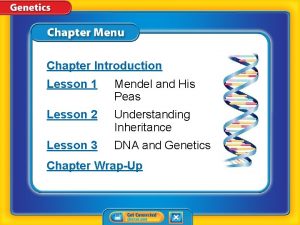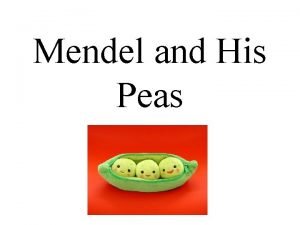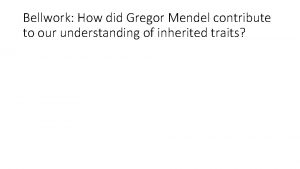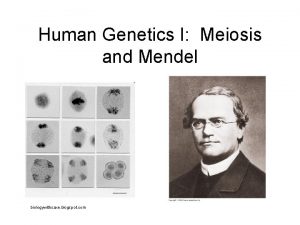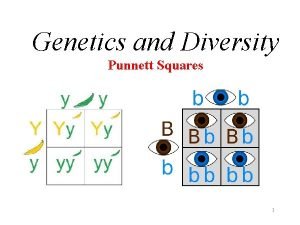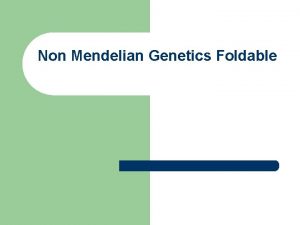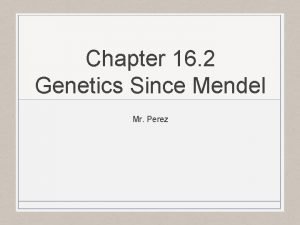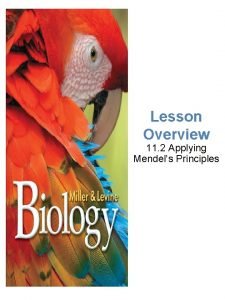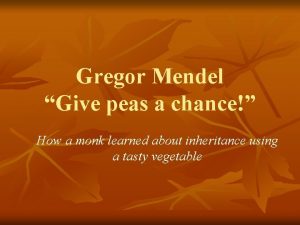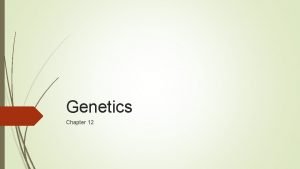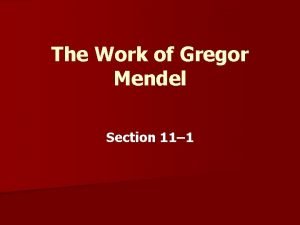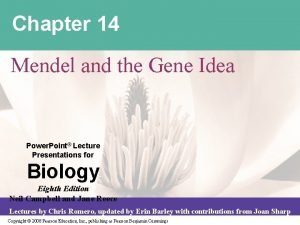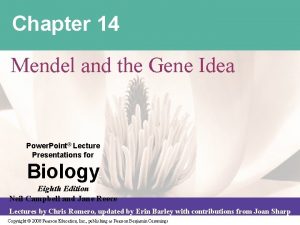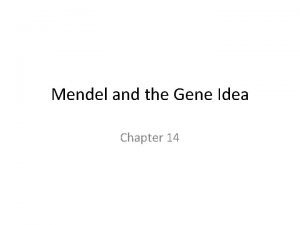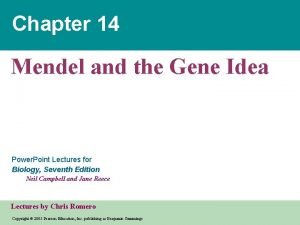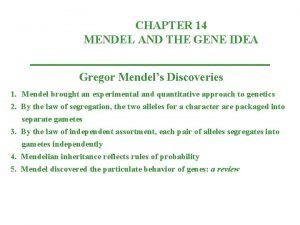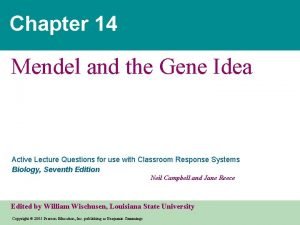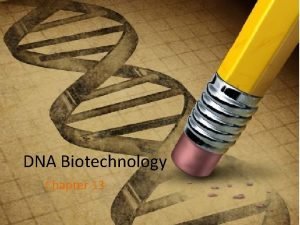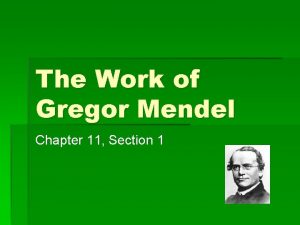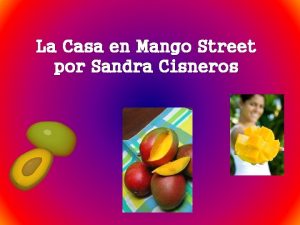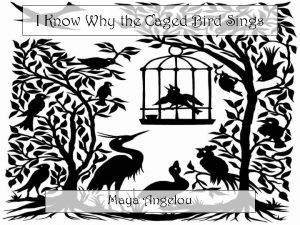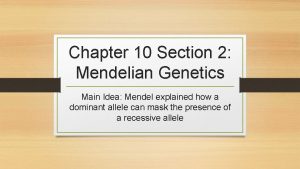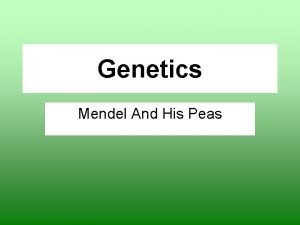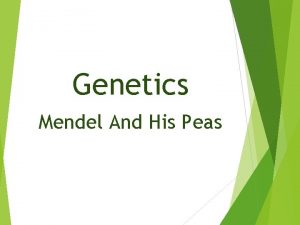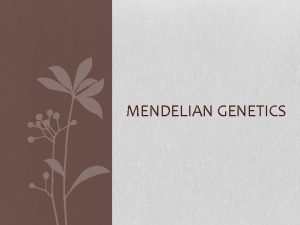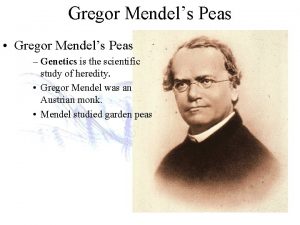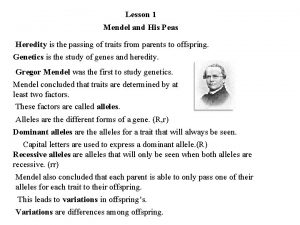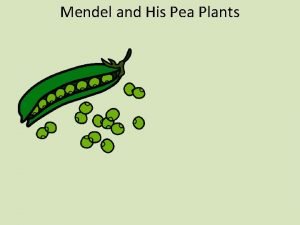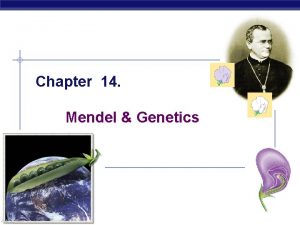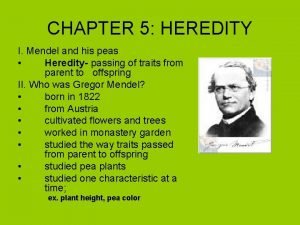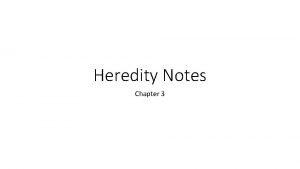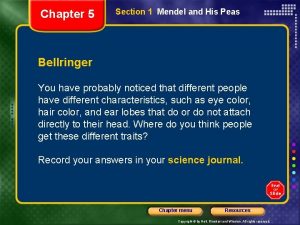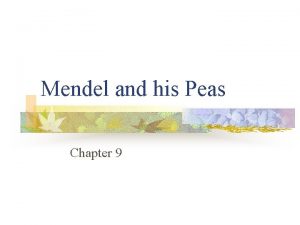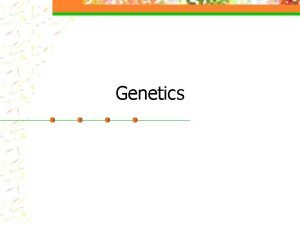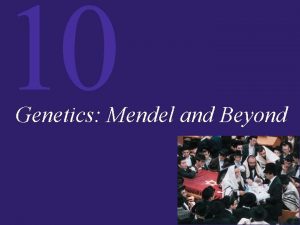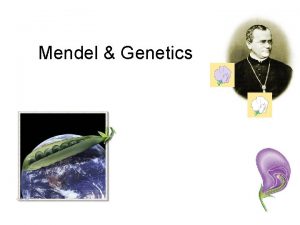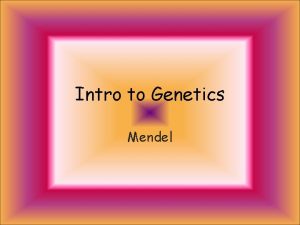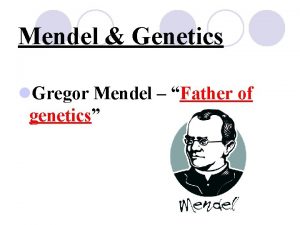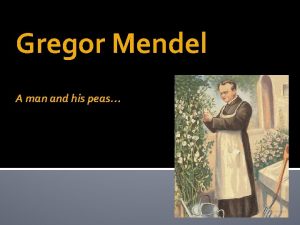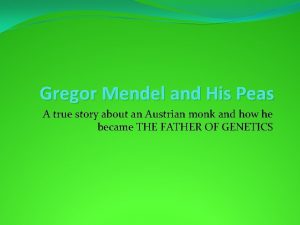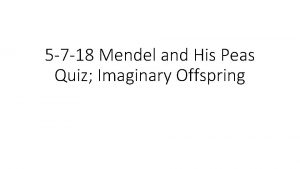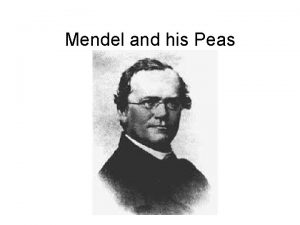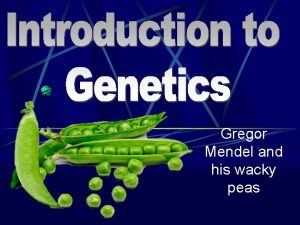Genetics Chapter 12 Mendel and His Peas Lesson



































- Slides: 35

Genetics Chapter 12

Mendel and His Peas Lesson 1

https: //www. brainpop. com/health/geneticsgrowt handdevelopment/heredity/

Heredity is the passing of traits from parents to offspring Genetics is the study of how traits are passed from parents to offspring

Mendel’s Experiment Mendel cross-pollinated selected plants and noticed patterns of inheritance

Dominant and Recessive Traits A genetic factor that blocks another genetic factor is called a dominant trait A genetic factor that is blocked by the presence of a dominant factor is called a recessive trait

Dominant and Recessive Traits Homozygous dominant: two dominant alleles Homozygous recessive: two recessive alleles Heterozygous: contains one dominant and one recessive allele (and presents with the dominant trait)


Understanding Inheritance Lesson 2

Controlling Traits Humans have 23 pairs of chromosomes Each pair has one chromosome from the father and one chromosome from the mother

Genes and Alleles A gene is a section on a chromosome that has genetic information for one trait The different forms of a gene are called alleles

Genotype and Phenotype The two alleles that control the phenotype of a trait are called the trait’s genotype How a trait appears, or is expressed, is the trait’s phenotype

https: //www. brainpop. com/health/geneticsgrowt handdevelopment/genetics/

Modeling Inheritance Punnett Squares or pedigrees can be used to determine genotypes and phenotypes of dominant and recessive traits

Punnett Squares Show a cross between two organisms

Patterns of Inheritance Incomplete dominance: when the offspring’s phenotype is a combination of the parent’s phenotype Codominance: when both alleles can be observed in a phenotype

Patterns of Inheritance Multiple alleles: when genes have more than two alleles Sex-linked traits: when the allele for a trait is on an X or a Y chromosome Polygenic inheritance: when multiple genes determine the phenotype of a trait

Genes and the Environment An organism’s environment can also affect its phenotype

If a pea plant with homozygous dominant genotype for a trait is crossed with a pea plant with a heterozygous genotype for the same trait, what is the ratio of the offspring? 2 homozygous dominant; 2 heterozygous; 0 homozygous recessive

DNA and Genetics Lesson 3

DNA Structure DNA provides the instructions for making proteins A chromosome is a long molecule of DNA is a double helix

Nucleotide A nucleotide is a molecule made of a nitrogen base, a sugar, and a phosphate group The four bases are: Adenine (A), Cytosine (C), Thymine (T), and Guanine (G)

https: //www. brainpop. com/health/geneticsg rowthanddevelopment/dna/

Chromosomes Chromosomes: Determine the traits of an organisms Provide instructions to make proteins Determine the gender of an individual

Cells Chromosomes are found in the nucleus of an animal and plant cell Bacteria do NOT have a nucleus

Replication The process of copying a DNA molecule to make another DNA molecule is called replication

Genes A gene is a section on a chromosome (or a sequence of DNA) that has genetic information for one trait Example of traits: hair color and height Genes come from both parents equally

Making Proteins Ribonucleic acid (RNA) is a type of nucleic acid that carries the code for making proteins from the nucleus to the cytoplasm The process of making m. RNA from DNA is called transcription

Translation The process of making a protein from RNA is called translation A codon is a sequence of three nucleotides


Central Dogma of Biology DNA RNA Protein Replication Transcription Translation

Size Order (from smallest to largest) DNA nucleotide Codon Gene Chromosome

https: //www. brainpop. com/health/geneticsgrowt handdevelopment/geneticmutations/

Mutations A change in the nucleotide sequence of a gene is called a mutation Types of mutations Deletion Insertion Substitution

Results of Mutations DNA makes proteins which express traits A mutation therefore can: Cause genetic disorders Not affect traits Create a trait that benefits the organism
 Mendel and his peas lesson 1
Mendel and his peas lesson 1 Mendel and his peas
Mendel and his peas Pp
Pp Mendel genetics
Mendel genetics Gregor mendel’s principles of genetics apply to
Gregor mendel’s principles of genetics apply to How did gregor mendel contribute to genetics
How did gregor mendel contribute to genetics Meiosis
Meiosis Punnett square
Punnett square Mendel's genetics foldable
Mendel's genetics foldable Genetics since mendel
Genetics since mendel Chapter 17 the beginning of the life cycle
Chapter 17 the beginning of the life cycle Chapter 12 lesson 2 applying mendels principles
Chapter 12 lesson 2 applying mendels principles Chapter 12 lesson 1 the work of gregor mendel
Chapter 12 lesson 1 the work of gregor mendel Chapter 12 lesson 1 the work of gregor mendel
Chapter 12 lesson 1 the work of gregor mendel Chapter 12 lesson 2 applying mendels principles
Chapter 12 lesson 2 applying mendels principles Why did mendel prevent his plants from self-pollinating?
Why did mendel prevent his plants from self-pollinating? Mendel and the gene idea chapter 14
Mendel and the gene idea chapter 14 Chapter 14 mendel and the gene idea
Chapter 14 mendel and the gene idea Chapter 11 mendel and the gene idea
Chapter 11 mendel and the gene idea Chapter 14 mendel and the gene idea
Chapter 14 mendel and the gene idea Chapter 14 mendel and the gene idea
Chapter 14 mendel and the gene idea Chapter 14 mendel and the gene idea
Chapter 14 mendel and the gene idea Chapter 10 sexual reproduction and genetics
Chapter 10 sexual reproduction and genetics Chapter 22 genetics and genetically linked diseases
Chapter 22 genetics and genetically linked diseases Chapter 10 sexual reproduction and genetics
Chapter 10 sexual reproduction and genetics Genetics and biotechnology chapter 13
Genetics and biotechnology chapter 13 Chapter 11 the work of gregor mendel
Chapter 11 the work of gregor mendel All summer thomas hears the sound of the ice cream truck
All summer thomas hears the sound of the ice cream truck Imagery in macbeth
Imagery in macbeth Mi nombre la casa en mango street
Mi nombre la casa en mango street Fat worms waiting on a dawn bright lawn
Fat worms waiting on a dawn bright lawn Chapter 7 extending mendelian genetics study guide answers
Chapter 7 extending mendelian genetics study guide answers Chapter 12 section 1: dna: the genetic material
Chapter 12 section 1: dna: the genetic material Chapter 12 section 1 molecular genetics answer key
Chapter 12 section 1 molecular genetics answer key Chapter 10 section 2: mendelian genetics
Chapter 10 section 2: mendelian genetics Identify the disorder
Identify the disorder
